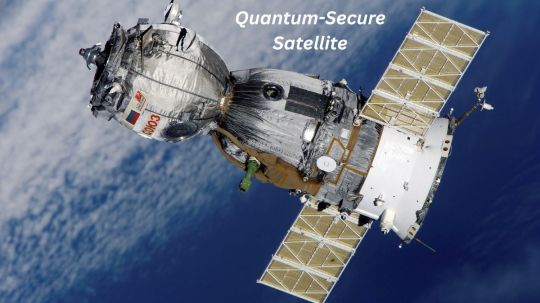#QuantumSecureSatellite
Explore tagged Tumblr posts
Text
India Accelerates Quantum-Secure Satellite To Space

A Quantum-Safe Satellite
India is developing quantum-secure satellite technology to protect its space infrastructure from quantum computing threats. This project is driven by the knowledge that quantum computers can crack algorithms and decrypt existing encryption methods. The nation is safeguarding defence communications and other important resources in the quantum era.
According to Matt Swayne's July 8, 2025 news article, Indian corporations are building the nation's first quantum-secure satellite. Space TS, a space systems engineering firm, and Synergy Quantum, a post-quantum encryption specialist, are working on this project. They collaborate to create and execute safe space-based technology. India's “Atmanirbhar Bharat” program for technological independence drives the partnership's goal of creating the country's first domestic quantum-secure satellite and strengthening its space infrastructure against quantum threats.
Its main technology isPost-Quantum Cryptography (PQC). PQC uses mathematical methods that are immune to quantum attacks and can be run on current hardware, making it easier to scale across current and future space infrastructure than Quantum Key Distribution (QKD), which uses quantum physics to secure keys. Quantum-resistant encryption will be added to every stage of the space communication stack to safeguard systems against quantum computers that could break Shor's Algorithm.
The following advances are expected from this collaboration:
Encrypted satellite packets.
Satellite-to-earth communications are secure.
Self-governing mission control systems resist manipulation and interception.
Swarms of quantum-resilient satellites.
Safe ground stations.
Space drones with quantum security for speedy response.
AI-powered satellites can reroute data, shift orbits, and respond to abnormalities without ground station assistance.
Developing safe orbital transfer vehicle navigation systems.
Satellite network “tip-and-cue” coordination. Hardened mission control uses quantum-secure protocols.
Synergy Quantum handles encryption, embedded security, and secure communications protocols, while Space TS handles spacecraft architecture, mission planning, and system integration. Both companies will develop hardware and software simultaneously to ensure end-to-end protection rather than adding encryption to existing systems. Space TS founder and CEO Ashok Saxena underlined the need of quantum-protecting command channels, telemetry, uplinks, and downlinks for mission integrity and national security. Synergy Quantum founder and CEO Jay Oberai stressed the partnership's importance in bolstering India's space infrastructure with quantum-safe encryption and advanced authentication.
R Anil Kumar's July 7, 2025, news item describes India's rapid development of hacker-proof, quantum-safe space technologies for its military. This urgency is due to recent hacks and security concerns, especially the vulnerability of systems like the Indian Constellation navigation system (NavIC) to quantum computing threats, particularly from China. Chinese quantum computing discoveries have proved they can crack traditional encryption, making India's systems vulnerable to interception.
The National Quantum Mission (NQM) and Department of Space are developing a quantum-secure satellite network using QKD and PQC VPNs to address this. QKD, based on quantum entanglement, permits encryption key exchange with instant eavesdrop detection, unlike PQC, which employs quantum-resistant algorithms. Ajai Chowdhry, Chairman of the National Quantum Mission's Governing Board, said the migration to quantum-secure communication will be accelerated and stressed the need for Indian IP hardware chips to protect data.
Long-distance QKD networks on LEO and higher satellites are projected to be integrated by early August, and the first quantum satellite will be revealed within two to three months of July 7, 2025. Defence satellites will have PQC systems that can establish digital signatures for every location, eliminating the need for ground station authentication keys and reducing key compromise. NQM will need satellite providers like ISRO to transport gear. Indian private satellite enterprises are building quantum-safe networks.
The National Quantum Mission (NQM) in India received ₹6,003 crore in funding in April 2023 to create inter-city quantum networks and secure satellite communication across 2000 km. India will launch its first quantum communication satellite in 2026 to enable ultra-long-distance QKD, joining the elite group of countries with space-based quantum connectivity. With ISRO and DRDO having shown entanglement-based quantum-secure communications over shorter distances, India's strategy combines fiber-based, free-space, and satellite-based quantum communication.
Many nations, notably the US and EU, are developing quantum-secure satellite communications pilot systems and quantum-resistant algorithms. India is a new quantum technology challenger and is fast developing its capacity, although the US, China, and EU have more funding and experience.
China is the undisputed leader in quantum communication and launched the Micius quantum satellite in 2016.India is developing its first quantum satellite for 2026 to extend terrestrial quantum communications beyond 300 kilometres. India has several mathematicians and software developers for quantum algorithms, error correction, and theoretical quantum information science research. U.S.-India Quantum Coordination Mechanism cooperation advances it.
In conclusion
In response to quantum computing's risks, India's National Quantum Mission and private companies are rapidly developing quantum-secure satellite technology. By developing PQC-hardened satellite systems and QKD capabilities, India hopes to establish a sovereign space-security architecture, reduce dependence on foreign infrastructure, and gain a competitive edge in secure satellite services, defence communications, and secure drone operations in the quantum era.
#QuantumSecureSatellite#quantumcomputing#cybersecurity#PostQuantumCryptography#QuantumKeyDistribution#quantumalgorithms#News#Technews#Technology#Technologynews#Technologytrends#Govindhtech
0 notes